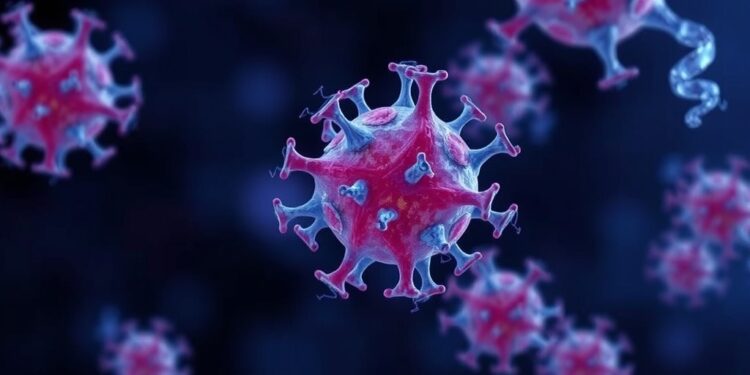Researchers at Northwestern University have recently unveiled a groundbreaking discovery regarding the protein Exportin-1, also known as Xpo1 or Crm1. Traditionally recognized for its role in the nuclear export of a variety of cellular materials, this protein is now being investigated for its additional functions in gene transcription. Through their recent studies, the researchers have opened the door to new understandings of cancer biology and the potential for innovative therapies. The importance of this research cannot be overstated, as Exportin-1 is frequently found at elevated levels in patients suffering from leukemia and other forms of cancer.
The discovery sheds light on the dual functionality of Exportin-1, suggesting that, in addition to facilitating the transport of molecules out of the nucleus, the protein may also engage directly in stimulating transcription processes. Transcription is the crucial mechanism by which cellular genes are expressed through the synthesis of RNA from DNA templates. Understanding the dual roles of Exportin-1 provides essential insight into how the regulation of gene expression may become disrupted in cancerous cells, leading to abnormal growth and division.
One of the key aspects of the research highlights Exportin-1’s ability to interact with transcription factors—regulatory proteins that control the transcription of specific genes. The research team found compelling evidence that Exportin-1 acts as a connector between transcription factors and the nuclear pore complex. This complex operates as a gateway, managing the exchange of molecules between the nucleus and the cytoplasm. Such interactions ensure that genes, once activated, advance toward the nuclear periphery, thus amplifying the expression of those genes associated with crucial cellular functions.
The implications of this research extend far beyond basic biology; they touch upon the very foundations of cancer therapy. Highlighting the overexpression of Exportin-1 in various malignancies, including leukemia, the study emphasizes that targeting this protein could provide a novel approach to cancer treatment. Unlike traditional chemotherapies that often indiscriminately attack rapidly dividing cells, a targeted approach to Exportin-1 could minimize the collateral damage to healthy cells, potentially leading to therapies that are far less toxic while maintaining efficacy.
Additionally, the findings reflect a deeper understanding of how deregulation of transcription may fuel oncogenesis—the process through which normal cells transform into cancerous cells. By promoting the expression of genes linked to cell proliferation, overactive Exportin-1 may create an environment conducive to tumor development. Therefore, the targeting of this protein in cancer therapy comes laden with the potential for significant breakthroughs in treatment methodologies and patient outcomes.
The research team’s findings also contribute to a more holistic view of cellular function within eukaryotes—organisms whose cells contain a nucleus. Utilizing budding yeast as a model organism, the researchers employed sophisticated methods ranging from single-molecule tracking to genome-wide mapping. Such methodologies not only enhance the credibility of their findings but also underscore the importance of yeast as a model system for understanding complex human cellular biology.
However, before any prospective therapies can be developed, the researchers aim to further explore the molecular interactions at play between Exportin-1 and the myriad transcription factors it influences. This groundwork will be crucial in determining whether the therapeutic modulation of Exportin-1 can be accomplished without inadvertently disrupting essential cellular functions, which may otherwise precipitate further complications.
Furthermore, a renewed understanding of the dual role of Exportin-1 emphasizes the need for a comprehensive approach to drug development that carefully considers both its nuclear export function and its role in transcription regulation. Determining the differential effects of inhibiting this protein’s function could catalyze the next generation of less toxic cancer medications.
Through persistent inquiry and innovative methodologies, the researchers continue to untangle the complexities of molecular interactions within cancer cells. Their work has profound implications, offering both a foundation for future studies and a potential roadmap for clinical applications aimed at combatting one of humanity’s most pervasive health threats.
Scientific endeavors like these illuminate the intricate web of cellular functions that underpin life and disease, reminding us that even familiar proteins can possess unexpected qualities. Understanding the multifaceted roles of proteins like Exportin-1 is a step toward harnessing the power of molecular biology in the fight against cancer, ultimately aiming for therapeutic advancements that could improve survival rates and the quality of life for cancer patients.
In conclusion, the discoveries surrounding Exportin-1 underscore its significant potential as a therapeutic target. As researchers continue to delve deeper into its dual functionalities, the hope is that more refined and effective cancer treatment strategies can emerge. These efforts encapsulate the spirit of scientific inquiry and the relentless pursuit of knowledge that may one day eradicate the scourge of cancer.
Subject of Research: Exportin-1 and its dual role in nuclear export and gene transcription
Article Title: Unraveling the Dual Function of Exportin-1: Implications for Cancer Therapy
News Publication Date: March 20, 2025
Web References: Molecular Cell
References: National Institutes of Health grants R35 GM136419, P41 GM109824, R01 GM112108, T32 NIGMS GM008061, and F32 GM153164
Image Credits: Northwestern University
Keywords: Cancer, Exportin-1, Gene Transcription, Leukemia, Molecular Biology




